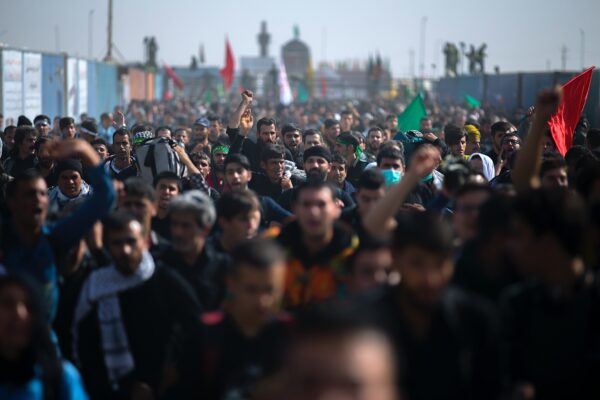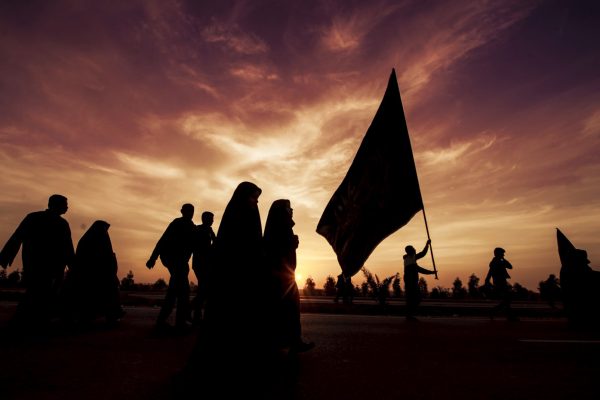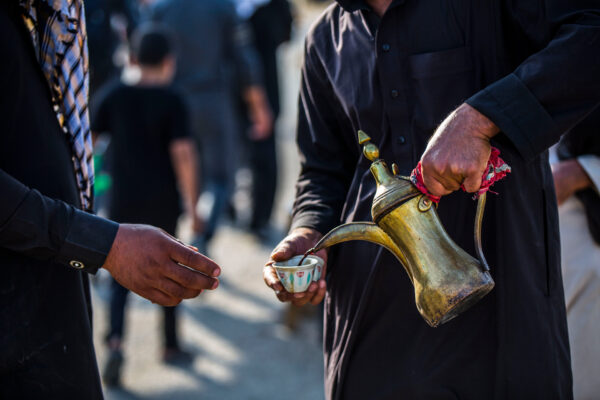“Helping out at the mawkib is easily the most challenging physical activity I’ve put myself through … at times I wanted to fall flat on my face and give up. But seeing herds of people walking to Imam Hussain with their flags and banners, people of all ages and nationalities uniting under one cause, was beautiful and empowering.”
“Helping out at the mawkib is easily the most challenging physical activity I’ve put myself through … at times I wanted to fall flat on my face and give up. But seeing herds of people walking to Imam Hussain with their flags and banners, people of all ages and nationalities uniting under one cause, was beautiful and empowering.”
The Arbaeen Walk is the largest annual peaceful gathering in the world.
In 2023, it attracted a staggering 22 million people. These were predominantly Shia Muslims but also people from other Islamic sects and other faiths altogether. Usually, the walk goes entirely under mainstream media radars. However, this year it was covered by UK outlets, ITV News and Al-Jazeera.
This year, I had the opportunity to volunteer and serve those millions of people undertaking the walk. I’m here to share my experiences – the good, the bad, and the ugly – for anyone interested in volunteering.
Hang on – what’s this walk all about?
Before getting into my experiences, let’s rewind. Many people reading this probably need background information like: what is Arbaeen? Where are people walking? Why are they walking?
Arbaeen is the Arabic word for the number 40. In this specific context, it refers to the 40th day after the martyrdom of Imam Hussain at the Battle of Karbala, which took place in Iraq, 61AH.
Imam Hussain is the grandson of the Prophet Muhammad (PBUH). In 61AH, he took a defiant stand against the tyrannical caliph, Yazid.
Yazid and his army trapped Imam Hussain, his companions, and his family in an area known as Karbala. They deprived them of water for three days before violently martyring nearly everyone in Imam Hussain’s camp.
The few survivors included Imam Hussain’s wife, sister, and children. Yazid took them as prisoners before releasing them due to growing pressure.
According to some historians, these surviving members stopped at Karbala on their return journey home, which happened to be on the 40th day since the battle (Arbaeen day).
Upon arrival, they saw Jabir ibn Abdullah al-Ansari, a prominent companion of the Holy Prophet (PBUH), at the gravesite of Imam Hussain. He officially became the first person to visit Imam Hussain on Arbaeen.
Ever since the tradition of visiting Imam Hussain on the 40th day of his martyrdom (Arbaeen day) became increasingly popular.
Imam Jafar as-Sadiq (the great-grandson of Imam Hussain) further recommended that those who love and cherish Imam Hussain should visit him on Arbaeen Day and, that too, by foot.
Imam Sadiq says each step to the grave of Hussain erases 1,000 sins, adds 1,000 rewards, and his/her status is elevated in the eyes of Allah by 1,000 degrees.
As a result, millions visit every year by foot to pledge and renew their allegiance to Imam Hussain. They go there to pay their respects and to make a commitment to personify his noble traits in their own lives.
Furthermore, visiting Imam Hussain is thought to make the Holy Prophet (PBUH) happy, who said:
Hussain is from me and I am from Hussain (AS), Allah loves those who love him.
Jami` at-Tirmidhi, vol.2, p.307
There’s no official ‘starting place’ for the walk. One can begin the walk from wherever they like. Some people walk from as far as Kuwait – approximately 700km!
It’s becoming increasingly common for people to walk to Karbala, the burial place of Imam Hussain, from Najaf, the burial place of his father, Imam Ali. This is an 80km walk which takes up to four days to complete.
The walk has been banned by various past rulers, most recently by the tyrannical dictator Saddam Hussein. However, after his fall in 2003, the restrictions were lifted.
What are mawkibs?
That was the brief history of how the walk crystallised. You can read more about it here.
But now the question arises: if you are walking for days on end, what do you eat? And where do you sleep?
That’s where mawkibs come into play.
Every year, several international organisations and the local population of Iraq set up mawkibs on the route from Najaf to Karbala and even further ahead to aid pilgrims on their journey. There’s no English equivalent of the word, but they can be likened to places of rest and recuperation.
Between Najaf and Karbala, there are approximately 1,400 mawkibs. They operate as camps providing anything a pilgrim would need, from food, shelter, and sanitation to medicine and a place to charge their phone.
These mawkibs do not charge a single penny for this service. They all do it out of their love for Imam Hussain. Mawkibs can look like anything ranging from a large, fully fitted-out facility, to a small tent with basic amenities.
I spent six days volunteering at one such mawkib.
Pre-Preparations
I travelled with a group who had been part of mawkib service for over a decade. The mawkib is primarily run by a group of volunteers from Pakistan but has a UK hub.
Prior to flying out to Iraq, we had two meetings. This was a chance for newbies like me to learn more about what to expect and for people to get to know each other.
Packing
We were not allowed to use our own suitcases to pack and were given duffle bags to use. We could only pack the bare essentials as the remaining luggage allowance was needed to pack the items needed for the mawkib.
Pro tip: Use packing cubes to maximise space, especially when baggage space is limited. Packing cubes are small, rectangular, and often zippered containers or organisers for packing clothes and other items in luggage or travel bags. They are typically made from lightweight and durable materials like nylon or polyester. Packing cubes come in various sizes and help travellers stay organized while packing and unpacking.
Responsibilities
The mawkib provides any type of medical assistance people might need, plus dental services. For much of the local population of Iraq, Arbaeen season is their one and only opportunity to access free and high-quality medical care, and it was heartwarming to see people have travelled far and wide to access this at our mawkib.
However, with no medical experience, I’d be assigned to preparing and serving food and drinks.
The six days at the mawkib
The mawkib I had the good fortune to volunteer at was a large building structure off the Najaf to Karbala highway with several large rooms for people to stop to rest in, a huge courtyard in the front where meals and drinks were served, a courtyard at the back where food and drinks were prepared, a medical camp for women and men, and a unisex dental camp, to only name a few facilities. The mawkib also had stalls for snack distribution closer to the main road, where most pilgrims were walking.
We arrived at the mawkib and were shown our living quarters. I’d be sharing a large room with about 50 other volunteers and sharing four bathrooms amongst us. No fancy facilities, just back to basics with the sole aim of serving the people.
It was slightly challenging as there were no beds, rather a bunch of mattresses arranged across the floor, and we were told to use any free mattress to sleep on. There was limited space to keep our luggage, so we kept it near where we slept or near the entrance.
But we had AC, which was crucial in 45°C heat!
Shift work begins
The mawkib ran 24/7, so we were all given shifts to ensure everyone gets to help and gets to rest.
My shift was from 3am until 10/11am. Here’s what I did.
3am to 4.30am: Prepare snacks
Part of a team of six to eight people, I’d head to the large container with 200 boxes of crisps and other snacks, and bring them out to the serving area.
One person would unbox the snacks, six would distribute them, and another would dispose of the waste.
4.30am to 5am: Pray Fajr Salah and take a short break
We stop serving to pray and take a quick tea break. I largely kept my energy up with copious amounts of sugar in my tea. It was the only way! For those who’ve never tried Iraqi tea, you’re missing out.
5am to 6.30am: Time for some kebabs!
I’d head to the kebab stations out on the highway to join a kebab-making conveyor belt. The female volunteers would slice the bread before Fajr Salah, and a handful of men would stuff each kebab in the morning. As part of the stuffing team, I filled the bread with pickles before handing it over to the next guy to add the meat, who then handed it to a third person to distribute.
7am to 8.30am: Drinks distribution
This was arguably the toughest part of the shift. The more the morning matures, the hotter it gets. We’d prepare a yoghurt drink known as laban/lassi/doogh (depending on what part of the world you’re from).
We’d bring out a number of yoghurt packets into the highway serving area and use them to fill up huge containers. Hose it down with water to create the drink, and add salt for flavouring. We’d also cut and bring forward huge ice blocks to keep it cool. Then a number of servers with jugs would scoop out the drink from the containers and serve it to those walking to Karbala.
9am: Breakfast distribution
Inside in the main courtyard, the mawkib had eggs, parathas, and chickpeas for breakfast every morning. This was primarily for those staying at the mawkib or stopping over for a few hours. Outside, at the serving stations on the motorway, a chicken and bread dish was prepared for anyone walking past the mawkib (but not stopping at the mawkib) to take on the go.
We were done at around 10am/10.30am. These were my repeated responsibilities.
Aside from that, I’d help clean dishes, distribute fruit, and keep the drinking water topped up.
Things other volunteers did
While my responsibilities were limited to outdoor serving, there were so many other things that needed to be done that helped the team:
- a team that cut fruit to make the juice
- a team that would prepare and serve breakfast
- individuals responsible for helping people with miscellaneous things such as charging their devices or finding their loved ones
- individuals who cleaned utensils for use again
- the medical camp, as mentioned above
Reflections at the mawkib
Upon completing the five days at the mawkib, we too visited Imam Hussain before returning home.
Helping out at the mawkib is easily the most challenging physical activity I’ve put myself through. Temperatures almost reached 50°C. The sun will cook you if your head’s not covered.
Lifting and serving (often at a fast pace) in such a climate were tough. At times I wanted to fall flat on my face and give up. Language was a barrier, too. It was often hard to understand people’s needs.
At the same time, it was a highly rewarding experience. Those receiving help – be it a meal or a glass of water – were grateful to receive it. When they smile at you (one even took a selfie with me!), it makes everything worth it.
I was trying to soak in the atmosphere when I wasn’t working or sleeping. Seeing herds of people walking to Imam Hussain with their flags and banners, people of all ages and nationalities uniting under one cause, was beautiful and empowering.





